
Calyceraceae is a plant family in the order Asterales. The natural distribution of the about sixty species belonging to this family is restricted to the southern half of South America. The species of the family resemble both the family Asteraceae and the Dipsacaceae.

Collomia grandiflora is a western North American annual plant in the phlox family (Polemoniaceae), known by the common names grand collomia, large-flowered mountain trumpet, and large-flowered collomia. It usually appears in sandy habitats and is cultivated as an ornamental.

Gentiana setigera is a species of gentian known by the common name Mendocino gentian. It is native to southern Oregon and northern California where it grows in wet places in the California Coast Ranges. It grows in serpentine soils.

Gentianopsis holopetala is a species of flowering plant in the gentian family known by the common names Sierra fringed gentian or just "Sierra gentian"'. It is native to the Sierra Nevada and adjacent mountains in California and Nevada, in wet meadows from 6000 to 11,000 ft in elevation. This is an annual or perennial herb, growing stems which may be anywhere from a few centimeters long to nearly half a meter, and may lay along the ground or grow erect. Its small oval or spoon-shaped leaves are mostly basal but may grow sparsely further along the stem.

Gilia stellata is a species of flowering plant in the phlox family known by the common name star gilia. It is native to the southwestern United States and northern Mexico, where it is a common resident of desert washes and sandy mountain slopes.
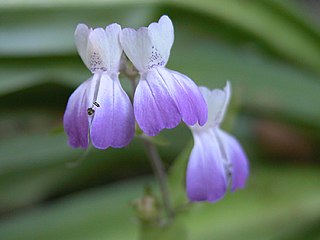
Collinsia multicolor is a species of flowering plant in the plantain family, known by the common names San Francisco blue eyed Mary and San Francisco collinsia. It is endemic to the San Francisco Bay Area, where it is known from San Francisco to Santa Cruz. As of 2008 there are 22 known occurrences. Populations south of Santa Cruz have been extirpated.

Collomia diversifolia is a species of flowering plant in the phlox family known by the common name serpentine collomia. It is endemic to California, where it is an uncommon member of the serpentine soils flora in the North Coast Ranges from the northern San Francisco Bay Area to Shasta County. It is a small annual herb with many branches bearing dark, slightly hairy, lance-shaped leaves, the most basal ones having three small teeth. The inflorescence is a cluster of several flowers each about a centimeter wide. The star-shaped flower has pointed violet lobes with yellowish bases coming together at a purple throat.

Collomia tinctoria is a species of flowering plant in the phlox family known by the common name staining collomia. It is native to the western United States from Washington to Montana to California, where it grows in open, rocky habitat in mountains. It is an annual herb producing a slender, branched stem no taller than about 8 centimeters. The glandular, hairy leaves are lance-shaped. The inflorescence is composed of two or three flowers emerging from the leaf axils. Each flower has pointed sepals tipped with awns. The flower has a purplish tube and a pinkish corolla.

Collomia tracyi is a species of flowering plant in the phlox family known by the common name Tracy's collomia. It is endemic to northern California, where it grows in the coniferous forests of the mountain ranges, including the Klamath Mountains. It is an annual herb producing a slender, branched stem no taller than about 8 centimeters. The glandular, hairy leaves are lance-shaped. The inflorescence is composed of two or three flowers emerging from the leaf axils. Each flower is white to lavender and up to 2 centimeters long. This species can be distinguished from the more common and widespread Collomia tinctoria by the positioning of the stamens and stigma in the flower.
Lessingia tenuis is a species of flowering plant in the daisy family known by the common name spring lessingia. It is endemic to California, where it is known from the San Francisco Bay Area to Ventura County. It grows on the slopes of the California Coast Ranges in common local habitat such as chaparral.
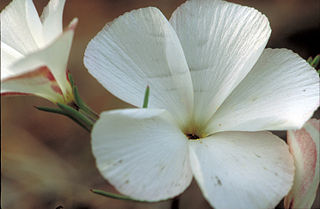
Linanthus dichotomus is a species of flowering plant in the phlox family known by the common name eveningsnow. It is native to western North America, including most of the southwestern United States, where it is a common member of the flora in a number of habitat types. It is often found on the serpentine soils of California. This is an annual herb producing several thin, waxy, erect stems up to 20 centimeters tall. The leaves are divided into linear lobes 1 or 2 centimeters long. The inflorescence produces a cyme of vespertine flowers which unroll into funnel-shaped corollas. The white lobes are just over a centimeter long and have purple shading on the undersides.

Nemophila heterophylla is a species of flowering plant in the borage family known by the common name small baby blue eyes.

Parentucellia latifolia is a species of flowering plant in the family Orobanchaceae known by several common names, including red bartsia, red tarweed, and broadleaf glandweed. It is native to Europe, but it can be found on other continents, including Australia, as an introduced species. This is an erect annual herb producing a stiff, slender stem coated in hairs and sticky glands. It reaches a maximum height near 30 centimeters. The hairy leaves are divided into triangular or lance-shaped lobes. The inflorescence is a raceme of flowers at the end of the stem. The flower is tubular, the calyx of sepals extending about halfway along the centimeter-long corolla. The corolla is magenta in color, sometimes with white areas, and bearing two raised yellow appendages in the lobed throat.

Phlox speciosa is a species of phlox known by the common name showy phlox. It is native to western North America from British Columbia to Arizona and New Mexico, where it occurs in sagebrush, pine woodlands, and mountain forests.
Scutellaria bolanderi is a species of flowering plant in the mint family known by the common name Sierra skullcap. It is endemic to California, where it is known from the Sierra Nevada and several of the mountain ranges to the south. It is a perennial herb producing an erect stem or cluster of stems 30 centimeters to one meter tall from a system of thin rhizomes. The stems are coated in short, spreading hairs which sometimes have resin glands. The oval or heart-shaped leaves have wavy edges and are oppositely arranged. The lowest leaves are borne on short petioles. Flowers emerge from the leaf axils. Each flower is held in a calyx of sepals with a large ridge or appendage on the upper part. The corolla is between 1 and 2 centimeters long and tubular in shape with a large upper and lower lip. The upper lip is folded into a beaklike protrusion and the lower has three wide lobes. The corolla is white or very pale blue with an area of blue mottling on the lower lip.
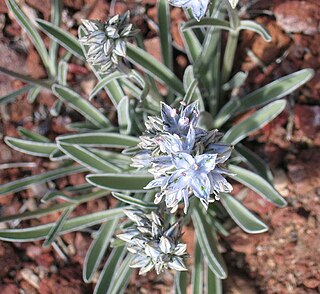
Frasera albicaulis is a species of flowering plant in the gentian family known by the common name whitestem frasera. It is native to the northwestern United States, where it grows in open areas in mountain habitat. It is a perennial herb growing from a woody base surrounded by rosettes of leaves, its stem growing 10 to 70 centimeters tall. The leaves are green with white margins. The basal leaves are lance-shaped, up to 30 centimeters long, and borne on petioles. Leaves higher on the stem are smaller and narrower and are oppositely arranged. The inflorescence is a dense panicle atop the stem, sometimes interrupted into a series of clusters of flowers. Each flower has a calyx of four pointed sepals and a corolla of four pointed lobes each one half to one centimeter long. The corolla is pale greenish white to light blue to purple, often dotted, streaked, or veined with darker blue. There are four stamens tipped with large anthers and a central ovary.
Frasera neglecta is a species of flowering plant in the gentian family known by the common name pine green gentian.
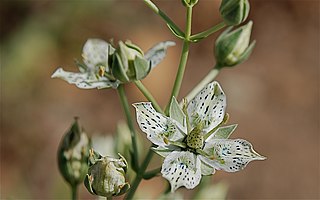
Frasera parryi is a species of flowering plant in the gentian family known by the common name Coahuila frasera.
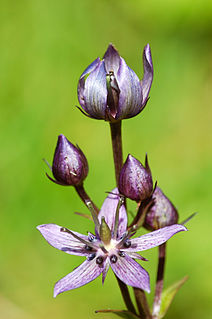
Swertia perennis is a species of flowering plant in the gentian family known by the common names felwort and star swertia. It is native to several regions of the northern hemisphere, including much of Eurasia and western North America. It is a plant of wetlands, particularly calcareous fens. It is common to abundant in many areas, but it is known to be negatively impacted by habitat fragmentation and other habitat destruction, and human activity has led to its extirpation from some areas where it was once common. It is a perennial herb producing usually one erect stem growing 10 to 50 centimeters tall. The basal leaves are spoon-shaped with rounded tips, and leaves higher on the plant are widely lance-shaped or somewhat oval, with pointed tips. The inflorescence is an open panicle of flowers atop the stem. Each flower has a calyx of four or five pointed sepals and a corolla of four or five pointed lobes each up to 1.3 centimeters long. The corolla is dull blue to violet in color with darker purplish veining or stippling. There are two rounded nectary pits at the base of each lobe of the corolla. Stamens tipped with large anthers surround a central ovary.
Frasera tubulosa is a species of flowering plant in the gentian family known by the common name Kern frasera.
















